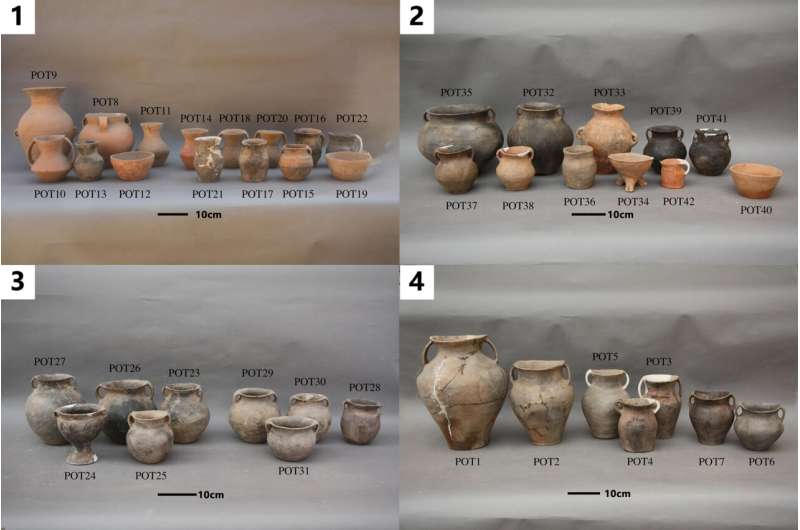Science
Ancient Brewing Revealed: Insights from Bronze Age China

A recent study led by Dr. Yinzhi Cui and his team has unveiled intriguing insights into the brewing practices of ancient China, specifically at the Bronze Age site of Mogou in Gansu Province. The researchers analyzed pottery residue from 42 vessels, revealing that the inhabitants of Mogou not only consumed a variety of plant-based foods but also practiced qu-based brewing, a traditional method of making alcoholic beverages.
The Mogou site, dating from 1700 to 1100 BC, was excavated between 2008 and 2012, uncovering over 1,688 graves and approximately 5,000 individuals. These remains are significant as they span two distinct cultural periods: the Qijia culture (2300–1500 BC) and the Siwa culture (1400–1100 BC). The graves, primarily designed in a catacomb style, provide a rich context for understanding the ritual practices of the time.
In their analysis published in the Journal of Archaeological Science: Reports, the researchers focused on pottery vessels from three key tombs: M499 from the Qijia culture, and M368 and M457 from the transitional period between Qijia and Siwa cultures, as well as tomb M576 from the Siwa culture. They discovered residues indicating the presence of various plants, including rice, millet, Job’s tears, buckwheat, and species from the Triticeae family, such as barley and wheat. This diversity suggests that the Mogou people had a varied diet rich in plant resources.
The findings also revealed starch granules that showed signs of enzymatic digestion, a clear indication of fermentation processes. Notably, the presence of Monascus mold suggested a sophisticated brewing technique, as this mold is integral to the qu-based brewing method. This method, which involves mixing qu with cooked starchy ingredients, enables the conversion of starches into sugars, setting the stage for fermentation.
Historical Context of Qu-Based Brewing
The qu-based brewing technique has ancient roots, originating in the Shangshan culture of the Lower Yangzi River around 8000 to 6000 BC and further developing in the early Neolithic cultures of the Yellow River region around 6000 to 5000 BC. By the time it reached Mogou, qu-based fermentation had become integral to mortuary rituals, likely serving to preserve ancestral memory and strengthen communal identity.
Dr. Cui emphasized the significance of this research, stating that it marks an important step towards understanding the cultural role of fermented beverages in the Bronze Age. The study not only highlights the technological advancements of the time but also sheds light on social practices surrounding death and memory.
While the current study provides valuable insights, Dr. Cui noted that further research is necessary. He stated, “As we plan to incorporate the latest research in the future, it is premature to draw a conclusion now.” The team intends to expand their research with larger sample sizes to better understand the brewing practices and their cultural implications.
The Mogou site continues to offer a wealth of information about ancient Chinese civilizations, and this recent analysis provides a compelling glimpse into the dietary habits and ritual practices of its people. As archaeological methods advance and more discoveries are made, the understanding of early Bronze Age cultures in China will undoubtedly deepen, revealing the complexities of their social structures and traditions.
-

 Lifestyle4 months ago
Lifestyle4 months agoLibraries Challenge Rising E-Book Costs Amid Growing Demand
-

 Sports4 months ago
Sports4 months agoTyreek Hill Responds to Tua Tagovailoa’s Comments on Team Dynamics
-

 Sports4 months ago
Sports4 months agoLiverpool Secures Agreement to Sign Young Striker Will Wright
-

 Lifestyle4 months ago
Lifestyle4 months agoSave Your Split Tomatoes: Expert Tips for Gardeners
-

 Lifestyle4 months ago
Lifestyle4 months agoPrincess Beatrice’s Daughter Athena Joins Siblings at London Parade
-

 World3 months ago
World3 months agoWinter Storms Lash New South Wales with Snow, Flood Risks
-

 Science4 months ago
Science4 months agoTrump Administration Moves to Repeal Key Climate Regulation
-

 Science3 months ago
Science3 months agoSan Francisco Hosts Unique Contest to Identify “Performative Males”
-

 Business4 months ago
Business4 months agoSoFi Technologies Shares Slip 2% Following Insider Stock Sale
-

 Science4 months ago
Science4 months agoNew Tool Reveals Link Between Horse Coat Condition and Parasites
-

 Sports4 months ago
Sports4 months agoElon Musk Sculpture Travels From Utah to Yosemite National Park
-

 Science4 months ago
Science4 months agoNew Study Confirms Humans Transported Stonehenge Bluestones









